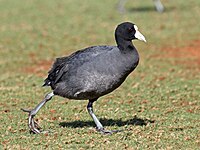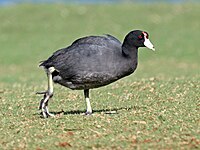Hawaiian coot
| Hawaiian coot | |
|---|---|

| |
| Hawaiian coot with yellowish frontal shield | |
| Scientific classification | |
| Domain: | Eukaryota |
| Kingdom: | Animalia |
| Phylum: | Chordata |
| Class: | Aves |
| Order: | Gruiformes |
| Family: | Rallidae |
| Genus: | Fulica |
| Species: | F. alai
|
| Binomial name | |
| Fulica alai Peale, 1849
| |
The Hawaiian coot (Fulica alai), also known as the ʻalae keʻokeʻo in Hawaiian, is a bird in the rail family, Rallidae, that is endemic to Hawaiʻi.[2] In Hawaiian, ʻalae is a noun and means mud hen.[3] Kea or its synonym keo is an adjective for white.[4] It is similar to the American coot at 33–40.6 cm (13–16 in) in length and weighing around 700 g (1 lb 9 oz). It has black plumage and a prominent white frontal shield. Its natural habitats are freshwater lakes, freshwater marshes, coastal saline lagoons, and water storage areas. The bird was federally listed in October 1970 as an endangered species [5] and is considered both endemic and endangered by the state of Hawaiʻi. It is threatened by habitat loss and introduced predators such as the small Asian mongoose.[1] The Makalawena Marsh on the Big Island of Hawaiʻi has been listed as a National Natural Landmark to preserve one of its last nesting areas.[6]
Endangered Species Listing
[edit]The Hawaiian coot was federally listed in October 1970 as an endangered species [7] and is considered both endemic and endangered by the state of Hawaiʻi.[8] The United States Fish and Wildlife Service's 5-year review, conducted in 2010, found that none of the four criteria established for delisting or downlisting of the species had been meet.[9] The delisting/downlisting criteria include protection and management of core and supporting wetlands, a population size greater than 2000 birds for five consecutive years, and multiple self-sustaining populations throughout the Hawaiian Islands.
Taxonomy
[edit]The first reference to a coot in the Hawaiian Islands was by Andrew Bloxam, who encountered the Hawaiian coot but failed to collect a specimen as he mistook it for the Eurasian coot, Fulica atra, while in the islands in 1825 as the naturalist on board HMS Blonde. It is now considered either to be a separate species, Fulica alai, or a subspecies of the American coot, Fulica americana alai.[10]
Population size
[edit]On Oʻahu, Maui, Molokaʻi and Kauaʻi, the Hawaiian coot was previously abundant in coastal brackish and fresh-water ponds, streams, and marshes;[11] however, the first censuses conducted in the 1950s and 1960s detected fewer than 1,000 birds statewide.[12] Since the 1960s, the interannual population size has fluctuated from less than 1,000 birds to over 3,000, and appears to be gradually increasing. Biannual surveys conducted by the Hawaiian Department of Land and Natural Resource's Division of Forestry and Wildlife (DOFAW) found that between 1998 and 2003 the inter-island coot population averaged 2,100 birds, ranging between 1,500 and 3,000 birds.[13] Recent surveys estimated winter populations fluctuating around 1,500 birds and a summer population fluctuating around 2,000 birds.[9]
Gallery
[edit]-
Hawaiian coot with white frontal shield
-
Hawaiian coot with red frontal shield
-
Hawaiian coot with red frontal shield
References
[edit]- ^ a b BirdLife International (2016). "Fulica alai". IUCN Red List of Threatened Species. 2016: e.T22692920A93374177. doi:10.2305/IUCN.UK.2016-3.RLTS.T22692920A93374177.en. Retrieved 13 November 2021.
- ^ "ʻAlae keʻokeʻo or Hawaiian coot" (PDF). Hawaii’s Comprehensive Wildlife Conservation Strategy. State of Hawaiʻi. 2005-10-01. Archived from the original (PDF) on 2013-11-03.
- ^ Parker, Henry H. "1". Hawaiian Dictionary: Hawaiian to English (see alae) (PDF). p. 47. Retrieved October 27, 2016.
- ^ Parker, Henry H. "5". Hawaiian Dictionary: Hawaiian to English (see kea) (PDF). p. 278. Retrieved October 27, 2016.
- ^ United States Fish and Wildlife Service. 1970. Conservation of Endangered Species and other Fish or Wildlife: United States List of Endangered Native Fish and Wildlife. Federal Registry 35: 16047-16048.
- ^ Makalawena Marsh Archived 2010-05-28 at the Wayback Machine on National Park Service web site
- ^ United States Fish and Wildlife Service. 1970. Conservation of Endangered Species and other Fish or Wildlife: United States List of Endangered Native Fish and Wildlife Federal Registry 35: 16047-16048.
- ^ Mitchell, C., C. Ogura, D.W. Meadows, A. Kane, L. Strommer, S. Fretz, D. Leonard, and A. McClung. 2005. Hawaii’s Comprehensive Wildlife Conservation Strategy. Department of Land and Natural Resources. Honolulu, Hawai‘i.
- ^ a b United States Fish and Wildlife Service. 2010. Hawaiian coot or ‘alae ke’oke’o (Fulica alai) 5-Year Review Summary and Evaluation. USFWS Pacific Island Fish and Wildlife Office, Honolulu, HI, 11 pp.
- ^ Olson, Storrs L. (1996), "The contribution of the voyage of H.M.S. Blonde to Hawaiian ornithology" (PDF), Archives of Natural History, 23 (1): 1–42, doi:10.3366/anh.1996.23.1.1, archived from the original (PDF) on 2011-07-18, retrieved 2009-12-07
- ^ Schwartz, C.W. and E.R. Schwartz. 1952. The Hawaiian Coot. The Auk 69: 446–449.
- ^ United States Fish and Wildlife Service. 2005. Draft Revised Recovery Plan for Hawaiian Waterbirds, Second Draft of Second Revision, Portland, Oregon, 155 pp. Available online at <http://www.fws.gov/endangered/species/recovery-plans.html>
- ^ United States Fish and Wildlife Service. 2005. Draft Revised Recovery Plan for Hawaiian Waterbirds, Second Draft of Second Revision, Portland, Oregon, 155 pp. Available online at <http://www.fws.gov/endangered/species/recovery-plans.html>.




